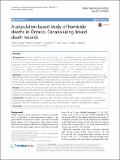A population-based study of homicide deaths in Ontario, Canada using linked death records
Abstract
Background: Homicide - a lethal expression of violence - has garnered little attention from public health researchers and health policy makers, despite the fact that homicides are a cause of preventable and premature death. Identifying populations at risk and the upstream determinants of homicide are important for addressing inequalities that hinder population health. This population-based study investigates the public health significance of homicides in Ontario, Canada, over the period of 1999-2012. We quantified the relative burden of homicides by comparing the socioeconomic gradient in homicides with the leading causes of death, cardiovascular disease (CVD) and neoplasm, and estimated the potential years of life lost (PYLL) due to homicide. Methods: We linked vital statistics from the Office of the Registrar General Deaths register (ORG-D) with Census and administrative data for all Ontario residents. We extracted all homicide, neoplasm, and cardiovascular deaths from 1999 to 2012, using International Classification of Diseases codes. For socioeconomic status (SES), we used two dimensions of the Ontario Marginalization Index (ON-Marg): material deprivation and residential instability. Trends were summarized across deprivation indices using age-specific rates, rate ratios, and PYLL. Results: Young males, 15-29 years old, were the main victims of homicide with a rate of 3.85 [IC 95%: 3.56; 4.13] per 100,000 population and experienced an upward trend over the study period. The socioeconomic neighbourhood gradient was substantial and higher than the gradient for both cardiovascular and neoplasms. Finally, the PYLL due to homicide were 63,512 and 24,066 years for males and females, respectively. Conclusions: Homicides are an important cause of death among young males, and populations living in disadvantaged neighbourhoods. Our findings raise concerns about the burden of homicides in the Canadian population and the importance of addressing social determinants to address these premature deaths.
Citation
Lachaud , J , Donnelly , P D , Henry , D , Kornas , K , Calzavara , A , Bornbaum , C & Rosella , L 2017 , ' A population-based study of homicide deaths in Ontario, Canada using linked death records ' , International Journal for Equity in Health , vol. 16 , 133 . https://doi.org/10.1186/s12939-017-0632-9
Publication
International Journal for Equity in Health
Status
Peer reviewed
ISSN
1475-9276Type
Journal article
Description
Funding: This study was funded by a Canadian Institutes for Health Research Operating Grant (FRN-142498). LR is supported by a Canada Research Chair in Population Health Analytics.Collections
Items in the St Andrews Research Repository are protected by copyright, with all rights reserved, unless otherwise indicated.

